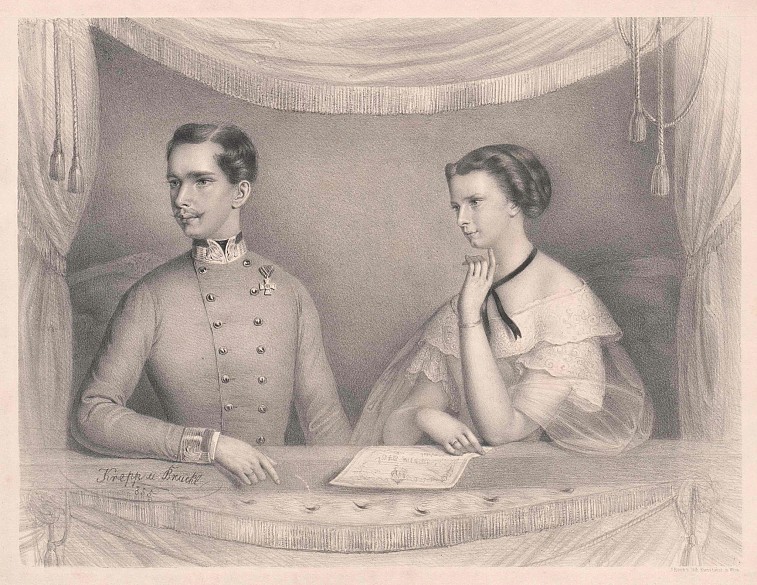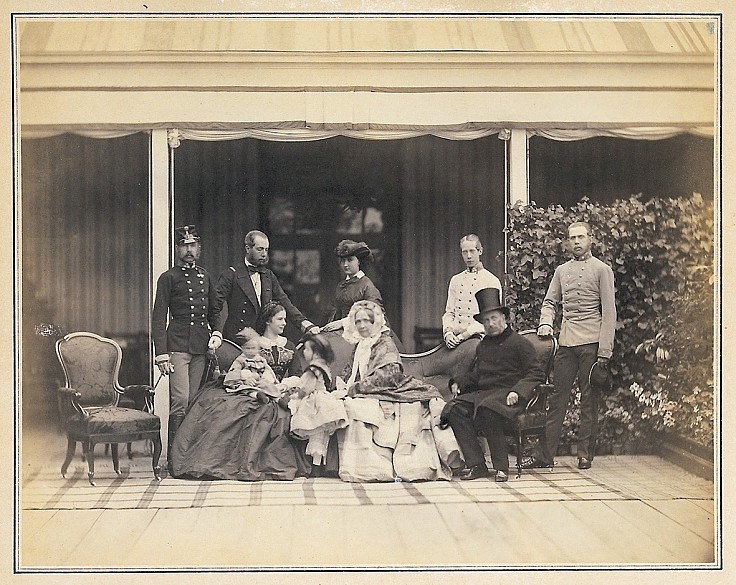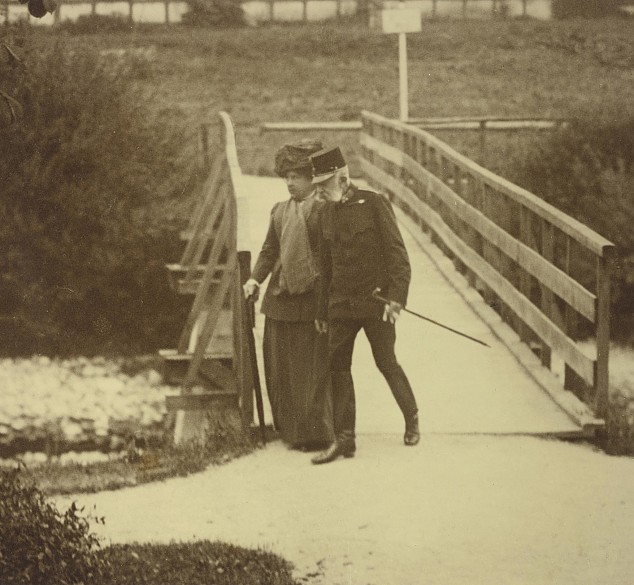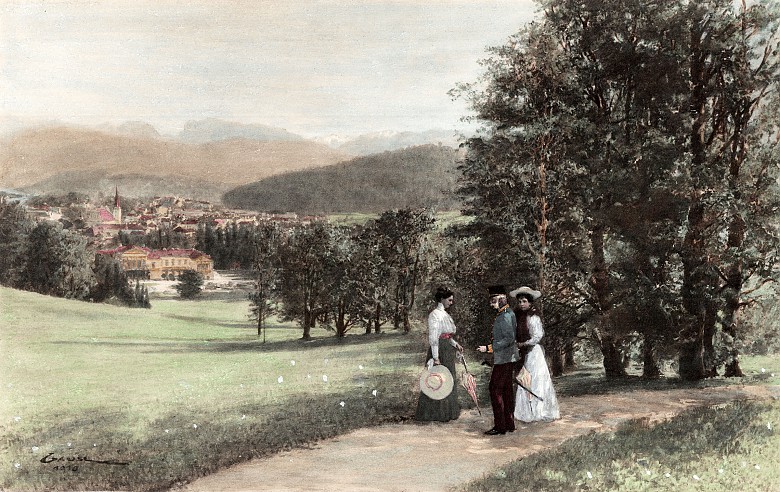Franz Joseph: Marriage, family and descendants
Two individuals in Franz Joseph’s close family have left equally deep marks on the historical consciousness of posterity. His wife Elisabeth, popularly known by her familiar name of Sisi, is today the most popular figure from the dynasty, and the tragic fate of his son Rudolf is still a subject of fascination for many people.
On 24 April 1854 Franz Joseph married his first cousin Elisabeth (1837–1898), who was seven years his junior and the daughter of one of his mother’s sisters. The romantic circumstances of their first encounter – it was in fact Elisabeth’s elder sister Helene who had been intended as the emperor’s bride – were popularized by the trilogy of ‘Sissi’ films made in the 1950s.
Franz Joseph loved his wife to a degree that bordered on infatuation, an affection that was however rarely returned. However, although the two were very different in character, over time a sort of friendship from a distance developed, as Elisabeth spent increasing periods away from her husband and the court.
The marriage produced four children:
Sophie Friederike (1855–1857), who died at the age of two from an intestinal infection.
Gisela (1856–1932), also spelled Gisella, grew up together with her brother Rudolf, who was two years younger, under the aegis of their grandmother, Archduchess Sophie, as Elisabeth was regarded as too young and inexperienced to take charge of their upbringing herself. This resulted in a certain distance in her relationship with her mother, which did not change as she grew up. However, Gisela enjoyed a good relationship with her father, whom in her matter-of-fact nature she closely resembled.
For much of her life Gisela was overshadowed by her brother, who as crown prince received far greater attention. Nonetheless, brother and sister were very close. Gisela was married to Prince Leopold of Bavaria (1846 –1930) at the age of sixteen. This was yet another union among many that had taken place between the Habsburgs and Wittelsbachs: Leopold was the son of the Bavarian prince regent, Luitpold, and the Habsburg archduchess Auguste Ferdinande from the Tuscan line of the dynasty, and was thus a second cousin of his bride. The marriage produced four children.
As an officer in the Bavarian army and a passionate sportsman, Prince Leopold was the perfect son-in-law for Franz Joseph. The emperor was very pleased at his daughter’s marriage and gave the couple, who resided at Munich, generous financial support. By contrast, Empress Elisabeth hardly kept in touch with her elder daughter and grandchildren; in one of her poems, which were kept secret during her life, she calls her conventional elder daughter, who was not very prepossessing in appearance, a ‘scrawny sow’, and her grandchildren ‘piglets’.
Franz Joseph’s relations with his only son Rudolf (1858–1889) were very problematic. The crown prince’s life is the subject of a separate biography on this site.
The youngest daughter, Marie Valerie (1868–1924), was born after an interval of ten years. She is generally seen as the ‘fruit’ of the Compromise with Hungary concluded in 1867, which Elisabeth had supported energetically. Born in Budapest, Marie Valerie was brought up by the empress as her ‘Hungarian child’. Elisabeth spoke only Hungarian with her youngest daughter, intending it to be her mother tongue. Elisabeth also took care that Marie Valerie was brought up to share her pro-Hungarian sympathies. Later in life, however, the daughter developed German Nationalist tendencies, possibly in reaction to her early upbringing.
Elisabeth idolized her youngest daughter and was able to devote all her energies to her upbringing, in contrast to her other children, who had grown up under the aegis of her mother-in-law, Archduchess Sophie. Like her mother Marie Valerie developed literary ambitions. However, it is her diaries, in which she proves a perceptive observer of the world around her, that hold the greatest interest for posterity.
In 1890 Marie Valerie married Archduke Franz Salvator (1866–1939), a distant relative from the Tuscan line of the Habsburg dynasty. The union resulted in ten children. The rapidly growing family resided at Schloss Wallsee in the west of Lower Austria. Even after her marriage Marie Valerie kept up close contact with her ageing father, who enjoyed the carefree atmosphere that prevailed in his youngest daughter’s family. Marie Valerie took an active interest in various charitable associations.
After the fall of the Habsburg Monarchy she adapted to the new circumstances, waiving all claims arising from her membership of the former ruling family, and was therefore permitted to remain in Austria with her family and keep her fortune and property. Today her descendants still live at Schloss Wallsee and at the imperial villa in Bad Ischl, which she inherited from her father in 1916.
Owing to Crown Prince Rudolf’s suicide, on the death of Franz Joseph the succession moved away from the emperor’s direct descendants to the line of his brother Karl Ludwig. However, Franz Joseph’s numerous descendants, including 15 grandchildren and 55 great-grandchildren, possessed huge assets, as he left his considerable private estate to his children and children’s children – and not to his successor on the throne, Karl I.
To round off the picture of the emperor’s life mention should be made of the most well.-known of his extramarital affairs. Although clearly against Catholic sexual morals, his behaviour in this respect was not unique but rather the custom among the upper echelons of the nobility.
Franz Joseph’s purely sexual relationship with Anna Nahowski (1860–1931) lasted from 1875 to 1889. It is possible that Franz Joseph was also the father of some of her children. His intimate friendship with the court actress Katharina Schratt (1853–1940), which was actively fostered by Elisabeth, began in 1885 and lasted until the emperor’s death.

















